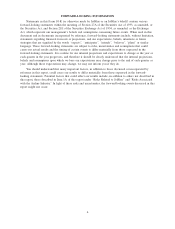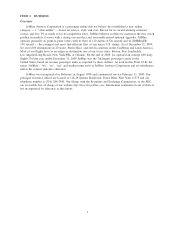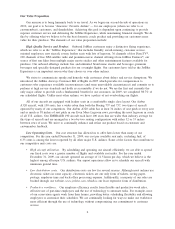JetBlue Airlines 2009 Annual Report Download - page 18
Download and view the complete annual report
Please find page 18 of the 2009 JetBlue Airlines annual report below. You can navigate through the pages in the report by either clicking on the pages listed below, or by using the keyword search tool below to find specific information within the annual report.certificates of airworthiness for all of our aircraft and have the necessary FAA authority to fly to all of the
cities we currently serve.
Like all U.S. certified carriers, we cannot fly to new destinations without the prior authorization of the
FAA. The FAA has the authority to modify, suspend temporarily or revoke permanently our authority to
provide air transportation or that of our licensed personnel, after providing notice and a hearing, for failure to
comply with FAA regulations. The FAA can assess civil penalties for such failures or institute proceedings for
the imposition and collection of monetary fines for the violation of certain FAA regulations. The FAA can
revoke our authority to provide air transportation on an emergency basis, without providing notice and a
hearing, where significant safety issues are involved. The FAA monitors our compliance with maintenance,
flight operations and safety regulations, maintains onsite representatives and performs frequent spot
inspections of our aircraft, employees and records.
The FAA also has the authority to issue maintenance directives and other mandatory orders relating to,
among other things, inspection of aircraft and engines, fire retardant and smoke detection devices, increased
security precautions, collision and windshear avoidance systems, noise abatement and the mandatory removal
and replacement of aircraft parts that have failed or may fail in the future.
The TSA operates under the Department of Homeland Security and is responsible for all civil aviation
security, including passenger and baggage screening, cargo security measures, airport security, assessment and
distribution of intelligence, and security research and development. The TSA also has law enforcement powers
and the authority to issue regulations, including in cases of national emergency, without a notice or comment
period.
In December 2009, the DOT issued a rule, which among other things, requires carriers to not permit
domestic flights to remain on the tarmac for more than three hours. The rule becomes effective in April 2010.
Violators can face fines up to a maximum of $27,500 per passenger. The new rule also introduces
requirements to disclose on-time performance and delay statistics for certain flights. This new rule may have
adverse consequences on our business and our results of operations.
We believe that we are operating in material compliance with DOT, FAA and TSA regulations and hold
all necessary operating and airworthiness authorizations and certificates. Should any of these authorizations or
certificates be modified, suspended or revoked, our business could be materially adversely affected.
We are also subject to state and local laws and regulations in a number of states in which we operate.
Airport Access. In January 2007, the High Density Rule, established by the FAA in 1968 to limit the
number of scheduled flights at JFK from 3:00 p.m. to 7:59 p.m., expired. As a result, like nearly every other
airport, the number of flights at JFK was no longer regulated and airlines became able to schedule flights
without restrictions. As a result of over-scheduling beyond the airport’s hourly capacity, congestion and delays
increased significantly in 2007.
JFK and its neighboring metropolitan area airports have experienced significant Air Traffic Control, or
ATC, related delays as a result of increasing scheduled and general aviation services since June 2006. The
magnitude of delays not only deteriorated air travel services in the New York area, but the entire air traffic
system in the United States. Consequently, the FAA imposed slot restrictions and hourly operational caps at
JFK and Newark’s Liberty International Airport with the goal of reducing system congestion in 2008. Despite
this action, the summer of 2008 was one of the most challenging periods for disruptive operations in the
New York metropolitan area. The delay level during this time actually surpassed the levels during the same
period of 2007 as ATC implemented daily ground delay programs at JFK. While JFK delays in 2009 were
much more manageable, the delay reductions were primarily driven by industry capacity reductions and a mild
summer in the New York area.
In an effort to reduce delays and modernize the airport, the FAA and the Port Authority of New York and
New Jersey, or PANYNJ, have been undertaking major construction work at JFK. Their plans include the
creation of new taxiways and holding pads, runway widening and rehabilitation, as well as the installation of
new ground radar, lighting and other navigation equipment. Most significantly, this project will include the
closure and rehabilitation of the most important runway in our network. The JFK runway is scheduled to be
9
























